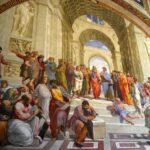The Sistine Chapel is, without a doubt, one of the greatest artistic treasures of the Vatican. It is also one of the main tourist attractions for visitors who decide to visit the fantastic works in the Vatican Museums.
History
The Sistine Chapel was built between 1471 and 1483. The chapel owes its name to the fact that at that time the pope was Sixtus IV, although it was originally called the Palatine Chapel. After having been abandoned for a long time, thanks to a very important person for Rome, Pope Sixtus IV. It was he who made a series of changes to the site and officiated at the inauguration of the church with a mass dedicated to the ascension of the Virgin Mary. The architect who built the Sistine Chapel was Giovanni de Dolci, although his name became secondary when Michelangelo’s first brush was placed on it.
The Sistine Chapel is rectangular in shape and measures 41 metres long by 13 metres wide and 21 metres high.
Known as the room where the conclave and other official Catholic ceremonies are held, the Sistine Chapel is also famous for being decorated by one of the greatest artists in history: Michelangelo Buonarroti, also known as Michelangelo.
In addition to Michelangelo, other artists such as Sandro Botticelli, Luca Signorelli, Perugino, Pinturicchio and Ghirlandaio participated in the decoration of the Sistine Chapel.
Video
The different scenes – called “frescoes” – that decorate the sides of the Sistine Chapel are the following:
- The Circumcision, Fresco by Pinturicchio.
- The Baptism of Jesus, fresco by Pinturicchio.
- The Story of Moses, Fresco by Sandro Botticelli.
- The Temptation of Christ, Fresco by Sandro Botticelli.
- The Crossing of the Red Sea, Fresco by Cosimo Rosselli.
- The Call of the Apostles, Fresco by Ghirlandaio.
- God handing the tablets of the law to Moses, Fresco by Cosimo Rosselli.
- Sermon on the Mount, Fresco by Cosimo Rosselli.
- Core, Dathan and Abiron, Fresco by Botticelli.
- Christ handing over the keys to Saint Peter, Fresco by Pietro Perugino.
- The Last Supper, Fresco by Cosimo Rosselli.Finally, the ceiling of the Sistine Chapel is divided into several sections:
- The vault, where the scenes from Genesis can be seen,
- The lunettes and the side spandrels, where the ancestors of Christ are represented,
- The triangles, where the prophets are depicted,
- And the corner spandrels or pendentives, where the four key stories of the salvation of God's people are found. The Creation of Adam, Michelangelo's famous scene, is included.How to get to the Chapel
Be careful what you wear, as short skirts or shorts, hats and bras are not allowed. If it is hot and you are wearing more open and low-cut clothes, don’t forget to change your clothes to cover your knees (especially for women).
Ticket price: 4 euros
https://www.museivaticani.va/content/museivaticani/it/collezioni/musei/cappella-sistina/storia-cappella-sistina.html
00120 Vatican City, Vatican City State
https://goo.gl/maps/JsSbUUkEUm3AumiZ9





